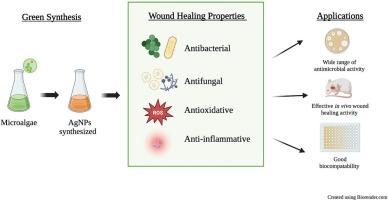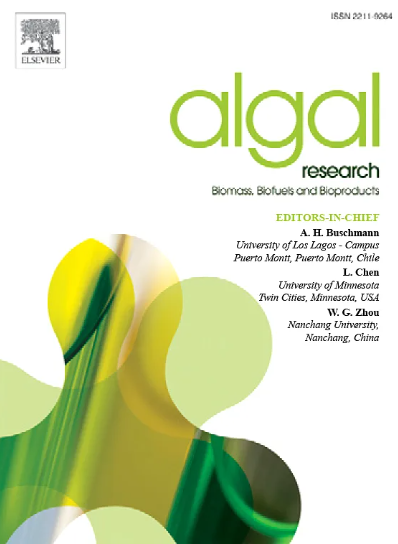微藻合成的生物银纳米粒子:生态友好型伤口愈合疗法综述
IF 4.6
2区 生物学
Q1 BIOTECHNOLOGY & APPLIED MICROBIOLOGY
Algal Research-Biomass Biofuels and Bioproducts
Pub Date : 2024-11-05
DOI:10.1016/j.algal.2024.103782
引用次数: 0
摘要
伤口一般是由皮肤损伤造成的,如割伤或刺伤。伤口可分为急性和慢性两类。伤口愈合不良会导致多种并发症,包括慢性疼痛、刺激、异味和感染。因此,必须尽快使用合适的疗法帮助伤口愈合,以减少这些并发症的发生,提高疗效。目前用于伤口护理的一些疗法,如纱布、类固醇药物、高压氧疗法和生物工程细胞结构等,可能会导致负面副作用,从而限制了它们在伤口护理中的应用。随着最新技术的发展,纳米技术已融入伤口愈合剂中,为治疗皮肤损伤提供了另一种治疗方法。在现有的含金属纳米粒子中,银纳米粒子(AgNPs)因其强大的抗菌特性,目前在伤口愈合应用中具有最大的潜力。然而,传统的纳米粒子合成方法由于使用有毒化学物质和产生有害废品,引起了健康和环境问题。本文章由计算机程序翻译,如有差异,请以英文原文为准。

Biogenic silver nanoparticles synthesized by microalgae: A comprehensive review of eco-friendly wound healing therapies
Wounds are generally caused by an injury to the skin such as a cut or a puncture. They can be considered in two groups, acute and chronic wounds. Poor wound healing can lead to multiple complications including chronic pain, irritation, unpleasant odours and infections. It is important, therefore, to assist wound healing using suitable treatments as rapidly as possible in order to reduce these complications and improve positive outcomes. Some currently available therapies used in wound care, such as gauzes, steroidal drugs, hyperbaric oxygen therapy and bioengineered cell constructions can lead to negative side effects, limiting their utilization in wound care. With recent advances, nanotechnology has been integrated into wound healing agents, providing an alternative therapeutic approach for the treatment of skin injuries. Amongst the available metal-containing nanoparticles, silver nanoparticles (AgNPs) currently have the greatest potential to be used in wound healing applications due to their strong antimicrobial properties. However, conventional methods of nanoparticle synthesis themselves raise health and environmental concerns due to their use of toxic chemicals and production of harmful waste products.
求助全文
通过发布文献求助,成功后即可免费获取论文全文。
去求助
来源期刊

Algal Research-Biomass Biofuels and Bioproducts
BIOTECHNOLOGY & APPLIED MICROBIOLOGY-
CiteScore
9.40
自引率
7.80%
发文量
332
期刊介绍:
Algal Research is an international phycology journal covering all areas of emerging technologies in algae biology, biomass production, cultivation, harvesting, extraction, bioproducts, biorefinery, engineering, and econometrics. Algae is defined to include cyanobacteria, microalgae, and protists and symbionts of interest in biotechnology. The journal publishes original research and reviews for the following scope: algal biology, including but not exclusive to: phylogeny, biodiversity, molecular traits, metabolic regulation, and genetic engineering, algal cultivation, e.g. phototrophic systems, heterotrophic systems, and mixotrophic systems, algal harvesting and extraction systems, biotechnology to convert algal biomass and components into biofuels and bioproducts, e.g., nutraceuticals, pharmaceuticals, animal feed, plastics, etc. algal products and their economic assessment
 求助内容:
求助内容: 应助结果提醒方式:
应助结果提醒方式:


